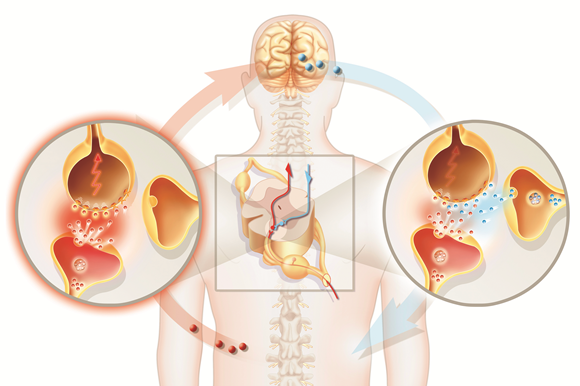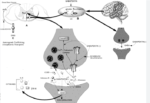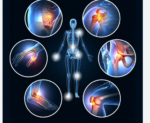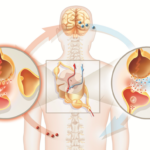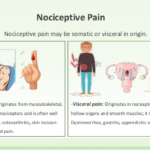Nociceptive pain is a term in the medical field used to describe pain that results from physical harm or the potential for harm to the body. On the other hand, neuropathic pain is the medical designation for pain that occurs when an injury or a medical condition disrupts or impairs the normal functioning of the nervous system.
Examples of nociceptive pain include the pain experienced following a sports injury, during a dental procedure, or due to conditions like arthritis.
Nociceptive pain is the most prevalent type of pain that individuals encounter. It arises when the nociceptive nerve fibers are activated by factors such as inflammation, chemical agents, or physical occurrences, such as accidentally bumping a toe against a piece of furniture.
This article concentrates on distinguishing between nociceptive pain and neuropathic pain, in addition to exploring their respective causes and treatment options.
What is Nociceptive Pain?
Nociceptive pain is a type of pain that arises in response to actual or potential tissue damage in the body. It is the body’s way of alerting you to harmful or potentially harmful stimuli. Nociceptive pain is typically well-localized, meaning you can pinpoint where the pain is coming from. It is a normal and protective response to injury or noxious stimuli.
Nociceptive pain is caused by the activation of specialized sensory nerve endings called nociceptors. These receptors are found throughout the body, including in the skin, muscles, joints, and internal organs. When tissue is damaged or irritated, nociceptors send electrical signals to the brain, which interprets these signals as pain.
This type of pain can be further categorized into two main subtypes:
- Somatic Nociceptive Pain: This pain arises from the activation of nociceptors in the skin, muscles, and joints. It is often described as a sharp, aching, or throbbing pain and is typically well-localized. Examples include the pain from a cut, burn, or bone fracture.
- Visceral Nociceptive Pain: Visceral pain is caused by the activation of nociceptors in the internal organs, such as the stomach, intestines, or liver. It is often described as a deep, dull, or cramping pain and can be more challenging to pinpoint. Visceral pain may also be referred, meaning that the pain is felt in an area different from the actual source of the problem.
Nociceptive pain serves a protective function by signaling the body to take action in response to injury. It prompts individuals to withdraw from painful stimuli, avoid further harm, and seek medical attention when needed.
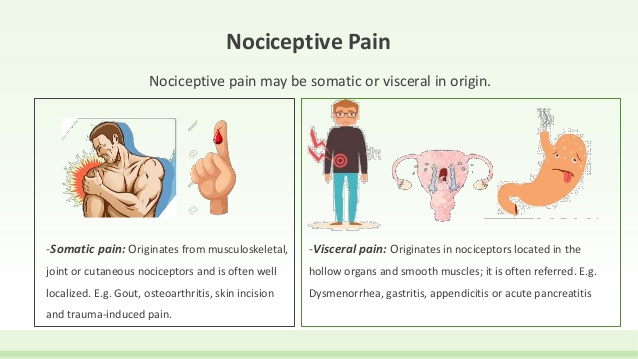
What is Neuropathic Pain?
Neuropathic pain is a type of chronic pain that results from damage or dysfunction in the nervous system, particularly in the peripheral or central nervous system. Unlike nociceptive pain, which arises from actual or potential tissue damage, neuropathic pain occurs as a result of abnormal signaling and processing of pain by the nerves. It is often described as a shooting, burning, tingling, or electric shock-like pain.
Key characteristics of neuropathic pain include:
- Abnormal Nerve Function: Neuropathic pain is caused by malfunctioning or injured nerves. This can occur due to various factors, including physical injury, disease, infection, or pressure on nerves.
- Chronic Nature: Neuropathic pain is typically chronic and long-lasting, often persisting beyond the healing of the initial injury.
- Spontaneous Pain: People with neuropathic pain may experience spontaneous pain, which means pain can occur without an obvious trigger or stimulus.
- Allodynia: Neuropathic pain can lead to allodynia, a condition where pain is felt in response to stimuli that are not typically painful, such as light touch or a gentle breeze.
- Hyperalgesia: Hyperalgesia refers to an increased sensitivity to painful stimuli, where minor sensations or pressure can cause intense pain.
- Paraesthesia: Patients may experience abnormal sensations like tingling, numbness, or pins and needles in addition to pain.
Common causes of neuropathic pain include:
- Peripheral Neuropathy: Damage to peripheral nerves, often caused by conditions like diabetes, chemotherapy, or infections like shingles.
- Nerve Compression: Conditions such as carpal tunnel syndrome or herniated discs can compress nerves and lead to neuropathic pain.
- Postherpetic Neuralgia: This occurs after a shingles infection and leads to persistent pain in the affected area.
- Central Nervous System Damage: Injuries or diseases affecting the brain or spinal cord can result in neuropathic pain.
Neuropathic pain is also referred to as nerve pain and is usually chronic.
Many different conditions and diseases cause neuropathic pain
including:
- diabetes
- multiple sclerosis
- stroke
- cancer
- cytomegalovirus
- amputation
Neuropathic Pain Can Happen if Your Nervous System is Damaged
Neuropathic pain can happen if your nervous system is damaged or not working correctly. You can feel pain from any of the various levels of the nervous system—the peripheral nerves, the spinal cord and the brain. Together, the spinal cord and the brain are known as the central nervous system. Peripheral nerves are the ones that are spread throughout the rest of your body to places likes organs, arms, legs, fingers and toes.
Damaged nerve fibers send the wrong signals to pain centers. Nerve function may change at the site of the nerve damage, as well as areas in the central nervous system (central sensitization).
Neuropathy is a disturbance of function or a change in one or several nerves. Diabetes is responsible for about 30% of neuropathy cases. It is not always easy to tell the source of the neuropathic pain. There are hundreds of diseases that are linked to this kind of pain.
Some Sources of Neuropathic Pain?
Neuropathic pain can be caused by diseases, including:
- Alcoholism.
- Diabetes.
- Facial nerve problems.
- HIV infection or AIDS.
- Central nervous system disorders (stroke, Parkinson’s disease, multiple sclerosis, etc.)
- Complex regional pain syndrome.
- Shingles. (Pain that continues after your bout with shingles ends is called postherpetic neuralgia.)
Other causes include:
- Chemotherapy drugs (cisplatin, paclitaxel, vincristine, etc.).
- Radiation therapy.
- Amputation, which can cause phantom pain.
- Spinal nerve compression or inflammation.
- Trauma or surgeries with resulting nerve damage.
- Nerve compression or infiltration by tumors.
The Symptoms of Neuropathic Pain?
Many symptoms may be present in the case of neuropathic pain. These symptoms include:
- Spontaneous pain (pain that comes without stimulation): Shooting, burning, stabbing, or electric shock-like pain; tingling, numbness, or a “pins and needles” feeling
- Evoked pain: Pain brought on by normally non-painful stimuli such as cold, gentle brushing against the skin, pressure, etc. This is called allodynia. Evoked pain also may mean the increase of pain by normally painful stimuli such as pinpricks and heat. This type of pain is called hyperalgesia.
- An unpleasant, abnormal sensation whether spontaneous or evoked (dysesthesia).
- Trouble sleeping, and emotional problems due to disturbed sleep and pain.
- Pain that may be lessened in response to a normally painful stimulus (hypoalgesia).
How is Neuropathic Pain Diagnosed?
Your healthcare provider will take a medical history and do a physical exam. If your provider knows or suspects you have nerve injury, they will recognize typical neuropathic pain symptoms. Your provider will then try to find the underlying cause of the neuropathy and trace the symptoms.
How is Neuropathic Pain Treated?
The goals of treatment are to:
- Treat the underlying disease (for example, radiation or surgery to shrink a tumor that is pressing on a nerve).
- Provide pain relief.
- Maintain functionality.
- Improve quality of life.
Multimodal therapy (including medicines, physical therapy, psychological counseling and sometimes surgery) is usually required to treat neuropathic pain.
![]()
Medicines commonly prescribed for neuropathic pain include anti-seizure drugs such as:
- Gabapentin (Neurontin®).
- Pregabalin (Lyrica®).
- Topiramate (Topamax®).
- Carbamazepine (Tegretol®).
- Lamotrigine (Lamictal®).
Doctors also prescribe antidepressants such as
- Amitriptyline (Elavil®).
- Nortriptyline (Pamelor®).
- Venlafaxine (Effexor®).
- Duloxetine (Cymbalta®).
Getting a prescription from your pain specialist for anti-seizure drugs or antidepressants does not mean you have seizures or are depressed. However, it’s true that chronic pain can be made worse by anxiety or depression.
Topical treatments like lidocaine or capsaicin—patches, creams or ointments—can be used on the painful area. Opioid analgesics are less effective in treating neuropathic pain, and negative effects may prevent their long-term use.
The pain can also be treated with nerve blocks given by pain specialists, including injections of steroids, local anesthetics, or other medicines into the affected nerves.
Neuropathic pain that has not responded to the therapies mentioned above can be treated with spinal cord stimulation, peripheral nerve stimulation and brain stimulation.
Pain Medications, Pain Relief, and Pain Management
